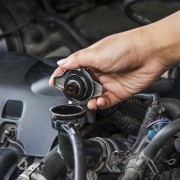A timing belt is like your engine's conductor, keeping the various parts running in proper time. Taking care of it can help you save on car repairs down the road.
- Browse Categories
- All Tips
-
Home & Garden
- All
- Appliances
- Bathroom
- Cleaning
- Crafts
- Decorating
- Electrical
- Flooring
- Furniture
- Garage Door
- Gardening
- Green Living
- Heating
- Home Alarm Systems
- Home Maintenance
- Home Remedies
- Home Security
- Home Staging
- House Sitting
- Junk Removal
- Kitchen
- Lawn Care
- Lock Systems
- Moving
- Outdoor Living
- Pest Control
- Plumbing
- Renovation
- Roofing
- Snow Removal
- Storage
- Tools
- Tree Service
- Health
- Family
- Travel
- Auto
- More Tips

How to protect your car's timing belt against damage
September 22, 2014

Your engine needs its timing belt
When it comes to auto maintenance and repair, don't forget to check the timing belt. Why? The belt’s name says it all: it keeps all of your engine’s parts moving together at the right time.
- A car timing belt connects the crankshaft and camshaft of your car’s engine.
- Think of it as a perfectly timed circular conveyer belt that brings the energy your engine produces to the shaft. It keeps your wheels rotating.
If the timing belt slips or breaks; your engine may get damaged, too.
Remember your timing belt — about every 80,000 kilometres
It's made of durable, heat-resistant rubber. So it withstands the constant work you demand of it, up to a point.
- Have your mechanic check your vehicle’s timing belt during your regularly scheduled auto maintenance.
If you have a newer car, you need to think about replacing the timing belt every 80,000 to 160,000 kilometres, or roughly every five to eight years.
What could possibly happen if you forget to replace the belt?
Vigilance is the way to avoid dealing with a worn-out timing belt. It may not give out clear warnings. It may just break altogether.
- This means the engine will simply stop, no matter where you are. Obviously, this can be very dangerous.
Save yourself extremely expensive engine repairs, possibly for pistons, valves, cylinders, camshaft and more.
- Pay for a new timing belt instead.
- For $500 to $1,000 including parts and labour (depending on your vehicle’s make and model), you can avoid a potentially disastrous situation.
How do I know when to check the timing belt?
Your failing timing belt may give you a lucky break by sending out a few warning signs. Get to your mechanic as soon possible if you notice any of these problems:
- Lots of exhaust because the engine is firing more.
- Hard to start the engine, especially if you have high mileage.
- Your car runs hot and the engine leaks onto the timing belt.
- Your car shakes because your engine’s timing is way off.






